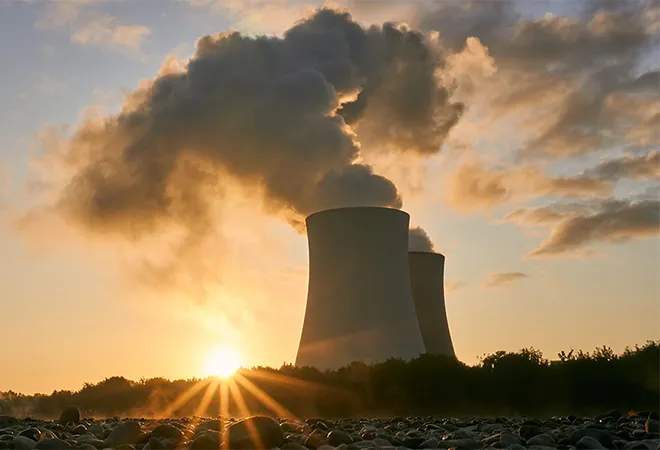 This piece is part of the series, 25 Years Since Pokhran II: Reviewing India’s Nuclear Odyssey
This piece is part of the series, 25 Years Since Pokhran II: Reviewing India’s Nuclear Odyssey
In May 1998, India’s self-declaration as a nuclear weapon power proved immensely consequential in resetting the terms of trade with supplier countries. The set of
five underground tests, expectedly, invited
sanctions from Western powers; New Delhi’s deft
handling of the post-Pokhran-II fallout induced a fundamental shift in the attitudes of Western powers towards India and fostered its accommodation in the nuclear mainstream. For over two decades, India had been subjected to crippling non-proliferation sanctions that aimed to stifle its strategic innovation systems, adversely affecting the country’s civil nuclear energy programme. The lack of fuel and access to assemblies and components from the international market saw India’s civilian programme
make do with sub-optimal construction and generating capacities.
The Indo-US nuclear deal, arguably an after effect of Pokhran II, led India’s Department of Atomic Energy (DAE) to seize the opportunity of international cooperation by charting ambitious nuclear power generation plans through a mix of indigenous and imported reactor technologies.
The success of India’s post-Pokhran II diplomacy, impressing the futility of Western sanctions, and explaining the country’s clean energy imperative would transform its strategic fortunes and help open the floodgates of international cooperation for its civil nuclear energy programme. The announcement of the historic Indo-US nuclear cooperation
initiative in 2004 (the “nuclear deal”) perhaps would not have materialised without New Delhi abjuring the prolonged self-restraint around its nuclear weapons capabilities and revising the Cold War-era atomic order. The Indo-US nuclear deal, arguably an after effect of Pokhran II, led India’s Department of Atomic Energy (DAE) to seize the opportunity of international cooperation by charting ambitious nuclear power generation
plans through a mix of indigenous and imported reactor technologies.
In 2008, following the India-specific
waiver from the Nuclear Suppliers Group (NSG), the DAE entered into cooperation agreements with several international suppliers to source reactor technologies and fuel. Having secured access to the global market, the DAE planned a quantum leap in the share of nuclear power in the country’s energy mix by committing to source about 40 GW of capacity from international
suppliers. Furthermore, the availability of uranium from the global market significantly boosted India’s existing reactor fleet, which had been operating well below its
rated capacities. Setting itself a target of installing about 63 GW of nuclear
power in the next two decades, the Indo-US nuclear deal generated immense momentum for the rapid growth of India’s civil nuclear energy sector.
However, the deadlocks precipitated by India’s Civil Liability for Nuclear Damage Act (CLNDA) passed by the Indian Parliament in September 2010 significantly postponed the realisation of such prospects. The stipulation of supplier liability obligations in the CLNDA significantly
deterred domestic and international suppliers and cast a shadow of uncertainty over India’s civil nuclear industry. Only after the DAE’s concerted efforts in
clarifying the contours of recourse and concurrent liability provisions in the CLNDA saw the domestic industry return to make bids for the construction of new reactors. The CLNDA, however, continues to be cited as a
hurdle in operationalising nuclear cooperation agreements with foreign players such as the United States and France.
The stipulation of supplier liability obligations in the CLNDA significantly deterred domestic and international suppliers and cast a shadow of uncertainty over India’s civil nuclear industry.
The DAE has only succeeded in executing contracts with Russia’s Atomstroyexport to supply
eight 1000-MW pressurised water reactors. With delays in setting up mega-nuclear parks in collaboration with the US and French suppliers, the DAE had to re-adjust its near-term capacity addition targets from the earlier projections of 2005-06. Owing to delays in concluding techno-commercial contracts with foreign powers, India’s plans to enhance the share of nuclear power primarily rests on indigenously developed pressurised heavy water reactor (PHWR) technology, the workhorse of India’s atomic energy programme. Over time, the DAE successfully mastered the PHWR technology, and the recent
commissioning of 700 MWe PHWR at Kakrapara marks a crucial milestone in scaling up the indigenous technology. The standardisation of the scaled-up PHWR and its proposed
fleet mode deployment has reignited the hopes of domestic industry. The progressive completion of 10 PHWRs in fleet mode, as the government announced in 2017, would help triple the
share of nuclear power from the existing 6780 MW to 22,480 MW by 2032.
In India’s contemporary developmental context, nuclear power represents an essential “non-fossil fuel energy” source. Notwithstanding the debate surrounding its labelling as a renewable or green energy course, its contribution to reducing CO2 emissions is vital. It reportedly saves about 41 million tonnes of CO2 emissions annually compared to coal-based plants. The current policy targeting a three-fold rise in the installed nuclear capacity by 2032 thus clearly needs an efficient follow-up. Managing
equity support and fostering
joint ventures (JVs) between public sector enterprises have been some of the fundamental policy changes in this direction. More importantly, the Indian private sector has its task cut out in addressing supply-chain bottlenecks and ensuring timely delivery of assemblies and components to achieve nuclear energy targets.
With delays in setting up mega-nuclear parks in collaboration with the US and French suppliers, the DAE had to re-adjust its near-term capacity addition targets from the earlier projections of 2005-06.
The current policy aiming to further India’s green transition and enhance the share of non-fossil sources, including nuclear power, offers the domestic industry an immense opportunity to boost local value addition. Notwithstanding the steady increase in demand from India’s power sector, the country remains woefully dependent on imports for power equipment and supply spares. China had been one of the largest suppliers of spares and assemblies to India’s power industry until the government banned importing Chinese power plant equipment following the Galwan Valley clashes in 2020. A robust import substitution policy with effective targeting of production-linked incentives (PLI) and preferential procurement is the need of the hour for boosting domestic productivity and value addition, as well as enhancing the competitiveness of Indian firms in the national and regional contexts.
In the past, India’s ambiguous stance on nuclear weapons afflicted the growth of the country’s civil nuclear energy sector. Although the Pokhran-II tests marked a clear break from the past, allowing the atomic energy sector to carve its distinct space, a well-designed and predictable policy regime is crucial to realise its real potential. The role of nuclear power in India’s long-term energy needs is clearly without dispute while driving domestic growth and productivity.
China had been one of the largest suppliers of spares and assemblies to India’s power industry until the government banned importing Chinese power plant equipment following the Galwan Valley clashes in 2020.
The world also closely watches India’s pursuit of the breeder- and thorium-based demonstration technologies. Post-Pokhran-II, lifting non-proliferation sanctions has proved a significant boon for these projects. Furthermore, India’s active participation in international projects like International Thermonuclear Experimental Reactor (ITER) adds to its science and technology prowess through novel research and
innovation partnerships. Since Pokhran II, India has come a long way in expanding its civil nuclear energy programme. New Delhi’s long-term energy security and green energy transition warrant New Delhi to recapitalise the historic opportunity for nuclear energy expansion and support its long-term growth through required policy interventions.
Kapil Patil, Ph.D. is a Postdoctoral Fellow at the Chair of Science, Technology, and Gender Studies at the University of Erlangen-Nuremberg.
The views expressed above belong to the author(s). ORF research and analyses now available on Telegram! Click here to access our curated content — blogs, longforms and interviews.



 This piece is part of the series,
This piece is part of the series,  PREV
PREV


